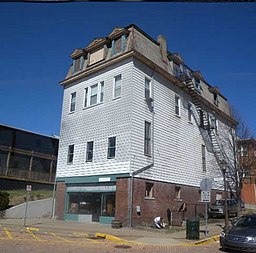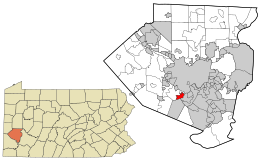Castle Shannon, Pennsylvania
| Castle Shannon | |
| Borough | |
|
Willow Avenue and Poplar Street
|
|
| Named for: Local farm named "Castle Shanahan" | |
| Country | United States |
|---|---|
| State | Pennsylvania |
| County | Allegheny |
| Elevation | 1,040 ft (317 m) |
| Coordinates | 40°21′57″N 80°1′11″W / 40.36583°N 80.01972°WCoordinates: 40°21′57″N 80°1′11″W / 40.36583°N 80.01972°W |
| Area | 1.6 sq mi (4.1 km2) |
| - land | 1.6 sq mi (4.1 km2) |
| - water | 0.0 sq mi (0.0 km2), 0% |
| Population | 8,316 (2010) |
| Density | 5,197.5/sq mi (2,006.8/km2) |
| Incorporated | December 20, 1919 |
| Mayor | Donald J. Baumgarten (D) |
| Timezone | EST (UTC-5) |
| - summer (DST) | EDT (UTC-4) |
| ZIP code | 15234 |
| Area code | 412 |
| School District | Keystone Oaks |
|
Location in Allegheny County and the state of Pennsylvania
|
|
|
Location of Pennsylvania in the United States
|
|
| Website: http://borough.castle-shannon.pa.us | |
Castle Shannon is a borough in Allegheny County, Pennsylvania, United States, and is part of the Pittsburgh Metro Area. The population was 8,316 at the 2010 census.
According to the United States Census Bureau, the borough has a total area of 1.6 square miles (4.1 km2), all of it land. Its average elevation is 1,040 feet (320 m) above sea level.
The first families settled Castle Shannon in 1786 in pursuit of farmland and timber. The most prominent farm was owned by David Strawbridge, who named it Castle Shanahan. Over time, the farm would lend its name to the area, as "Shanahan" would evolve into "Shannon". In 1872, the Pittsburgh and Castle Shannon Railroad line was completed, providing a direct link from Pittsburgh to the then-village of Castle Shannon. Development was stimulated by two years of free transportation and lumber transport given to anybody building a home.
In 1877, a second railroad was built from Finleyville through Castle Shannon to the West End neighborhood of Pittsburgh. In 1909, the right of way through the valley containing Castle Shannon was purchased by the Pittsburgh Railroad. This helped lead to Castle Shannon becoming a center for coal mining, with eight mines in operation in 1904. The Pittsburgh and West Virginia Railroad, still active today, came shortly afterward.
The First National Bank in Castle Shannon was the site of a much publicized bank robbery in 1917. $18,500 was taken in the robbery, of which $10,500 was immediately recovered from one man shot during the escape. The full sum was never recovered. Castle Shannon was incorporated as a borough in 1919, formed from parts of Baldwin Township, Mt. Lebanon, and Bethel Township.
As of the census of 2000, there were 8,556 people, 3,859 households, and 2,288 families residing in the borough. The population density was 5,259.8 people per square mile (2,026.7/km²). There were 4,037 housing units at an average density of 2,481.8 per square mile (956.3/km²). The racial makeup of the borough was 96.91% White, 1.34% African American, 0.06% Native American, 0.78% Asian, 0.01% Pacific Islander, 0.39% from other races, and 0.50% from two or more races. Hispanic or Latino of any race were 0.98% of the population.
...
Wikipedia



